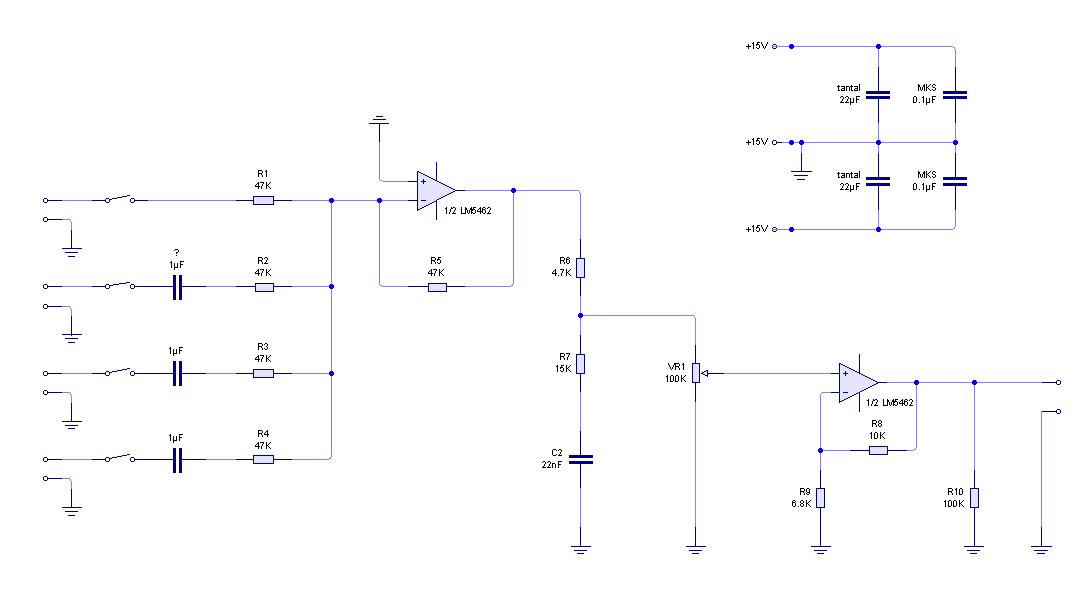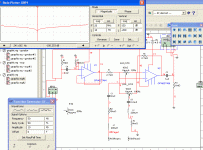Hello everybody!
I need your opinion about opamps for active filter and preamp.
Now I have 2 variants
- use LM4562 / LME49710 for both: preamp and filter
- use LM4562 for preamp and something else for active filter. For example TLE2072
Is there a problem in using the same type of opamp for both? Some weakness of opamps can be multiplied?
Filters outputs will go to 6x3886 amplifiers. But this may change.
Thanks.
I need your opinion about opamps for active filter and preamp.
Now I have 2 variants
- use LM4562 / LME49710 for both: preamp and filter
- use LM4562 for preamp and something else for active filter. For example TLE2072
Is there a problem in using the same type of opamp for both? Some weakness of opamps can be multiplied?
Filters outputs will go to 6x3886 amplifiers. But this may change.
Thanks.
Hey man, are you designing/building a preamp? I'm trying to design a preamp and I'm using multisim at the moment using two LC filters to cut/boost at certain frequencies. But, the signal gets boosted/cut by 100dB at the centre frequencies and the LC filters cut/boost way too much of the rest of the signal! Grr.
When I dial my potentiometers either side the cut and boost by the 100dB amount i mentioned at their extreme settings but if the potentiometers are somewhere in the middle then nothing happens to the grequency response of the signal!
Any ideas will be hugely appreciated. Thanks.
When I dial my potentiometers either side the cut and boost by the 100dB amount i mentioned at their extreme settings but if the potentiometers are somewhere in the middle then nothing happens to the grequency response of the signal!
Any ideas will be hugely appreciated. Thanks.
Attachments
Hi Jenks, just looking at your simulation, try having a look at the values of R6 and R2. You seem to have micro and mili farads in there as well.
Regards Karl
Regards Karl
jenks said:Hey man, are you designing/building a preamp? I'm trying to design a preamp and I'm using multisim at the moment using two LC filters to cut/boost at certain frequencies. But, the signal gets boosted/cut by 100dB at the centre frequencies and the LC filters cut/boost way too much of the rest of the signal! Grr.
When I dial my potentiometers either side the cut and boost by the 100dB amount i mentioned at their extreme settings but if the potentiometers are somewhere in the middle then nothing happens to the grequency response of the signal!
Any ideas will be hugely appreciated. Thanks.
100dB? Try to search for "elliptic filter" (or something like this) But this is only for cutting. I don't see how you can achieve 100dB boost.
------------------------------------------------------------------------------------
When I dial my potentiometers either side the cut and boost by the 100dB amount i mentioned at their extreme settings but if the potentiometers are somewhere in the middle then nothing happens to the grequency response of the signal!
Any ideas will be hugely appreciated. Thanks.
------------------------------------------------------------------------------------
Hi Jenks,
Looks like your input resistor r1 is way too low and the gain r8 as well, try r1 100k and r8 5.6k up and see the difference.
mc
When I dial my potentiometers either side the cut and boost by the 100dB amount i mentioned at their extreme settings but if the potentiometers are somewhere in the middle then nothing happens to the grequency response of the signal!
Any ideas will be hugely appreciated. Thanks.
------------------------------------------------------------------------------------
Hi Jenks,
Looks like your input resistor r1 is way too low and the gain r8 as well, try r1 100k and r8 5.6k up and see the difference.
mc
No worries, I've decided to stop simulating circuits and actually build something! Gonna try the TS-9 circuit before doing my own LC filters though. just wanna get something working before I start experimenting with my own designs!
I was really hoping to incorporate 12AX7 valves in the circuit instead of the semi-conductor diodes. But I was told I can't because you need 100volts for the 12AX7's to even work! Is this true?!
Jenks.
I was really hoping to incorporate 12AX7 valves in the circuit instead of the semi-conductor diodes. But I was told I can't because you need 100volts for the 12AX7's to even work! Is this true?!
Jenks.
Back to original subject. I have ordered LM5462 for preamp and OPA2134 for filters. I have to wait ~1 week until delivery.
Until than, I would like some comments on following schematic:

Until than, I would like some comments on following schematic:

Looks good to me, there's a small typo in your PSU, good to see you using inverting config for opamp, use this for second opamp to maintain phase. Very similar to my own design, the virtual earth arrangement allows a series shunt switching arrangement with small signal FETS that gives TOTAL isolation between inputs and allowed for easy remote control. I would add small caps across feedback resistors to optimise overshoot on squarewave test, you would have to determine these by measurement as the layout affects this. R7/C2 Explain please 😉. Watch the grounding, use electrolytics rail to rail and small 0.1's rail to ground, with small eg 1mfd soldered directly across I/C supply pins. I use local shunt zener stabilisation on mine, better than regs for low current requirement IMO. It's looking good. A 10k pot might be better (stray capacitance on wiper affecting squarewave response) and lower impedance less prone to pickup. If this is the final stage include a small eg 68 ohm output resistor to isolate the opamp output from any cable effects. Include a 100k to ground at each input to give a D.C. path for any equipment that has just an output cap unterminated so to speak (very unlikely) and you can do away with the 1mfd input caps.
It's all looking good.
Regards Karl
It's all looking good.
Regards Karl
Mooly said:Looks good to me, there's a small typo in your PSU, good to see you using inverting config for opamp, use this for second opamp to maintain phase. Very similar to my own design, the virtual earth arrangement allows a series shunt switching arrangement with small signal FETS that gives TOTAL isolation between inputs and allowed for easy remote control. I would add small caps across feedback resistors to optimise overshoot on squarewave test, you would have to determine these by measurement as the layout affects this. R7/C2 Explain please 😉. Watch the grounding, use electrolytics rail to rail and small 0.1's rail to ground, with small eg 1mfd soldered directly across I/C supply pins. I use local shunt zener stabilisation on mine, better than regs for low current requirement IMO. It's looking good. A 10k pot might be better (stray capacitance on wiper affecting squarewave response) and lower impedance less prone to pickup. If this is the final stage include a small eg 68 ohm output resistor to isolate the opamp output from any cable effects. Include a 100k to ground at each input to give a D.C. path for any equipment that has just an output cap unterminated so to speak (very unlikely) and you can do away with the 1mfd input caps.
It's all looking good.
Regards Karl
Thanks for your suggestions.
R6-R7-C2 is a variable (with frequency) divider. It is used for BSC.
The output from this stage will go to an active filter. The filter is inside the same box.
I don't think that phase is important, since this is only a stereo setup and both channels will be similar.
BSC Wazzat then 😉 . Phase inversion ? From a purist point of view correct phase is essential, as to whether it's audible or not, and is it correct on the recordings anyway, I am not so sure. Just swap speaker leads over and see if you can tell any difference.
Now for something I can't really back up. I do prefer to use the inverting configuration for Op-Amps for audio work, it's more docile under transient conditions and more "forgiving" in "lash ups" And I think it sounds better. 🙂
Regards Karl
Now for something I can't really back up. I do prefer to use the inverting configuration for Op-Amps for audio work, it's more docile under transient conditions and more "forgiving" in "lash ups" And I think it sounds better. 🙂
Regards Karl
- Status
- Not open for further replies.
- Home
- Amplifiers
- Chip Amps
- Opamp for active filter and preamp
